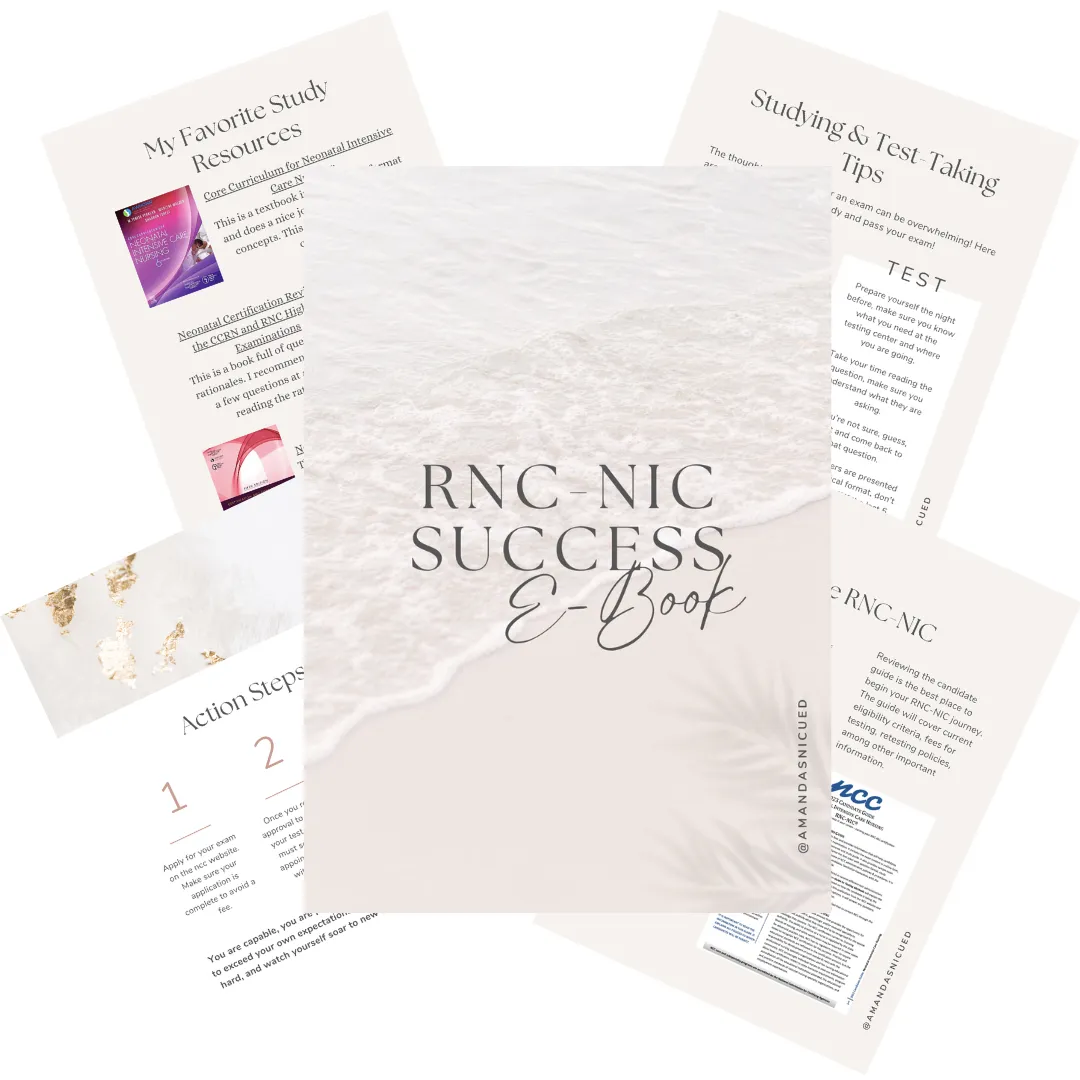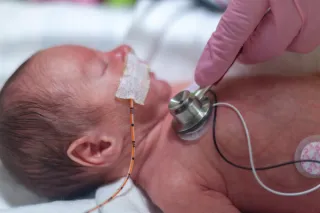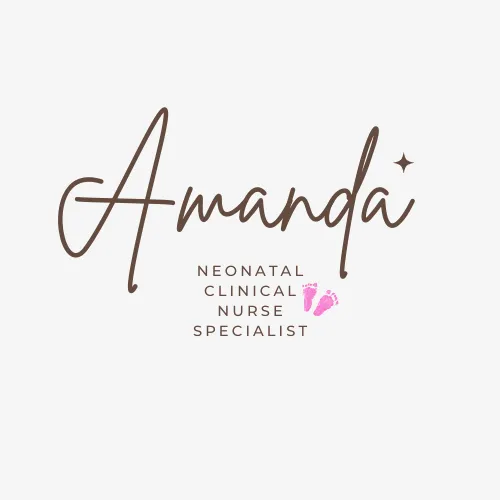
Welcome to Amanda's NICU Education




Hi! My name is Amanda. I'm a NICU nurse, Clinical Nurse Specialist, NICU Educator... basically your NICU BFF. If you want to talk NICU, I'm here for you! I love everything about NICU nursing and I'm eager to learn and share my knowledge with all my NICU friends.
I have been a NICU nurse since 2009 I am currently a Clinical Nurse Specialist in a Level IV NICU in Los Angeles.
I am passionate about educating the next generation of NICU nurses. I share my knowledge through platforms such as Instagram and Facebook and am excited to have you here on my website!
Click on the button below to sign up for my newsletter filled with NICU education and tips for all experience levels.

Not very many people love taking tests but as a self-acclaimed "forever student" who has taken (and passed) five different certification exams I am no longer afraid of tests! "Way to brag", you might be thinking but I want to help YOU pass your certification exam too!
Introducing Amanda's RNC-NIC Success digital course - your ultimate study companion!
Gain unlimited, on-demand access for life, ensuring you're primed to ace your certification exam.
I'm here to help you succeed and I can't wait for you to share with me that you PASSED the RNC-NIC EXAM!!!










Neonatal Blood Pressure
“Understanding neonatal blood pressure is a multifaceted challenge. It requires meticulous consideration of various factors, including gestational age, birth weight, and the neonate's clinical context .”
Have you ever been told that normal newborn blood pressure is simply a matter of matching the MAP to the baby's gestational age? It's a quick rule of thumb, but the world of neonatal blood pressure is more complex than that. In this blog, let's explore the nuances of neonatal blood pressure.

Understanding Neonatal Blood Pressure
Blood pressure (BP) is a vital sign that we routinely measure. It plays a crucial role in assessing our patients overall health and well-being. However, defining what is "normal" when it comes to neonatal blood pressure isn't as straightforward as it may seem.
Blood pressure is shown as a systolic, diastolic, and mean arterial pressure (MAP). The systolic pressure (top number) is the pressure against the artery walls during contraction. The systolic blood pressure is directly proportional to the stroke volume of the left ventricle. The diastolic (bottom number) is the pressure against the artery walls during relaxation, or in between the contractions. The diastolic blood pressure is influenced by systemic vascular resistance and volume status. The MAP is a calculated average of systolic and diastolic over a cardiac cycle. We often use the MAP to define hypotension, hypertension, and "normal" blood pressure, but the evidence to support that practice is lacking.
Challenges in Determining "Normal" BP
Published nomograms provide broad ranges of BP values for neonates of different gestational ages (GA). These guidelines are essential, but they only paint part of the picture. In premature newborns, determining a "normal" blood pressure is particularly challenging because of the unique physiology and the inherent differences from term babies.
In healthy adults and full-term babies, researchers have had the luxury of collecting extensive data to establish what is considered normal. However, premature babies are not part of this "normal" population due to their unique characteristics, immaturity, and complex physiology. As a result, neonatal BP can be variable, with values that can differ based on factors like GA, birth weight, transition to extrauterine life, illness, and the immature myocardium.
Pulse Pressure
As if it weren't complicated enough, we don't only look at the systolic, diastolic, and MAP. We also need to evaluate the pulse pressure. The pulse pressure is the difference between the systolic and diastolic blood pressures. Term infants have an average pulse pressure of 25-30 mmHg and premature infants have an average pulse pressure of 15-25 mmHg. A widened pulse pressure (>30 in term babies and >25 in preterm babies) may be a sign of a large aortic runoff lesion (such as a PDA). Narrow pulse pressures (<25 in term babies and <15 in preterm babies) may be a sign of peripheral vasoconstriction, heart failure, or low cardiac output.

Zubrow AB, Kushner H, & Falkner B. (1995)

Nuntnarumit, Yang, Bada-Ellzey (1999)
Methods for Measuring Blood Pressure
Neonatal BP measurement methods encompass both invasive and non-invasive techniques, each with its pros and cons.
Invasive BP Monitoring This method involves inserting a catheter into an umbilical, radial ,or posterior tibial artery. Invasive monitoring provides continuous intra-arterial BP values and is considered the gold standard. However, it's typically reserved for critically ill neonates due to its technical challenges and potential complications (e.g. thrombosis, bleeding, infection, necrosis distal to the site, or catheter migration).
Oscillometric Devices These devices use a cuff and monitor to detect pulsations within the artery. The cuff inflates above the systolic BP and then slowly deflates to determine the mean arterial BP. Computer-generated algorithms specific to each device manufacturer calculate systolic and diastolic BP values. These devices offer a less invasive option but can still provide valuable BP measurements.
When using oscillometric devices it is very important that the blood pressure cuff is the correct size for the patient. A cuff that is too small will provide a falsely high reading and a cuff that is too small will provide a falsely low reading. Aim for a cuff width 40-50% the circumference of the extremity.
Challenges and Considerations
If there is any question or concern for congenital heart disease, a murmur is heard, femoral pulses are absent, or blood pressures are difficult to obtain the NICU nurse should obtain four extremity blood pressures. Typically the lower extremities have a slightly higher blood pressure compared to the arms. A significantly higher blood pressure in the upper extremities (especially in combination with absent or weak femoral pulses) should increase suspicion of coarctation of the aorta. (Hint: Know that for the certification exam).
What influences Blood Pressure?
Blood pressure is the amount of blood ejected from the heart. It is the product of cardiac output and systemic vascular resistance. Cardiac output is determined by the heart rate and stroke volume. Babies in the NICU have a limited ability to increase their cardiac output, they can only increase their heart rate (not their stroke volume). Stroke volume is determined by preload, afterload, and contractility of the heart.
In addition to all the cardiovascular factors the nervous system and several hormones also influence blood pressure. The autonomic nervous system, consisting of sympathetic & parasympathetic states, stimulate the heart to regulate heart rate and contractility. Humoral mechanisms of the kidneys and pituitary glands (remember the renin-angiotensin-aldosterone system from school?) also assist in maintaining blood pressure.

Hypotension and Hypertension in Neonates
Hypotension Defining hypotension in neonates remains a subject of debate. Traditional definitions often involve a mean arterial pressure (MAP) less than the gestational age in weeks or a BP below the 5th or 10th percentile for gestational and postnatal age. Preterm infants are at an increased risk for hypotension, especially immediately after birth. Treating hypotension can be challenging. There is very little evidence to support the treatment of hypotension in premature infants, and the evidence we have is over 20 years old. I could write a whole other newsletter on this topic alone... let me know if that is something you would be interested in.
Hypertension Defining hypertension in neonates is complex and is more commonly seen in NICU babies with chronic lung disease or who have a history of an umbilical arterial line. It's often based on BP values above the 95th percentile for postmenstrual age. Some experts suggest treatment for asymptomatic hypertension when BP consistently exceeds the 99th percentile. Neonatal hypertension can result from various factors, including perinatal events and underlying conditions particularly renovascular and parenchymal diseases (e.g. Renal vein thrombosis, polycystic kidney disease).
Wrapping it up...
Understanding neonatal blood pressure is a multifaceted challenge. It requires meticulous consideration of various factors, including gestational age, birth weight, and the neonate's clinical context. While the definitions and management approaches continue to evolve, our unwavering commitment to providing the best care for our patients remains consistent. I hope you found this to be helpful! Email me or DM me on instagram any other topics you want to review. I love hearing from all of you!
Amanda xoxo
Reference:
Batton B. (2020). Neonatal Blood Pressure Standards: What Is "Normal"?. Clinics in perinatology, 47(3), 469–485. https://doi.org/10.1016/j.clp.2020.05.008
Dionne J. (2021). Determinants of Blood Pressure in Neonates and Infants. Hypertension, 77(3), 781-787. https://doi.org/10.1161/HYPERTENSIONAHA.120.14587
Versmold, H. T., Kitterman, J. A., Phibbs, R. H., Gregory, G. A., & Tooley, W. H. (1981). Aortic blood pressure during the first 12 hours of life in infants with birth weight 610 to 4,220 grams. Pediatrics, 67(5), 607–613.
Fanaroff, J. M., & Fanaroff, A. A. (2006). Blood pressure disorders in the neonate: hypotension and hypertension. Seminars in fetal & neonatal medicine, 11(3), 174–181.
Zubrow AB, Kushner H, Falkner B. (1995). Determinants of blood pressure in infants admitted to neonatal intensive care units: A prospective multicenter study. Journal of Perinatology 15(6): 472
Nuntnarumit, P., Yang, W., & Bada-Ellzey, H. S. (1999). Blood pressure measurements in the newborn. Clinics in perinatology, 26(4), 981–x.
Barnes J, Jnah A, Dias PL. (2023) Hypotension and Shock in Fetal and Neonatal Pharmacology for the Advanced Practice Nurse. Springer. 10.1891/9780826158840
Shead S. L. (2015). Pathophysiology of the Cardiovascular System and Neonatal Hypotension. Neonatal network : NN, 34(1), 31–39. https://doi.org/10.1891/0730-0832.34.1.31

December 2023 Certification Review Webinar
NICU Certification Review



Ready to kickstart your journey to becoming a certified NICU nurse?
Look no further!
Grab my FREE E-Book packed with essential study and test-taking strategies for the RNC-NIC.
In the E-Book I give you the resources you need including the link to access the candidate guide, several types of books to study from, some of my favorite strategies, an outline of the content you should review, and a blank calendar for you to make your study plan!
Frequently Asked Questions About the RNC-NIC exam

What is the RNC-NIC?
The RNC-NIC is a competency-based exam that tests the specialty knowledge of nurses in the United States & Canada who care for critically ill newborns and their families.
The RNC-NICU is a nationally recognized certification that recognizes the registered nurse for their specialty knowledge and skill.

Who can take the RNC-NIC exam?
Nurses can take this exam after a minimum of two years experience in the NICU caring for critically ill newborns and their families.

Which books should I use?
I'm glad you asked! There are many excellent books to help you prepare for the RNC-NIC, I gathered ande describe each of them for you in my FREE e-book.
Is there a course to help me study?
Yes! Many hospitals host their own certification course and there are a few online courses. See my RNC-NIC test taking tips E Book for more information
What happens if I don't pass the exam?
If you don't pass the exam on your first try you can try again after 90 days. You will have to reapply after 90 days and pay a retest fee. There is no limit to the number of times you can take the exam (however a candidate can only sit for the exam twice per year).

Can I make more money if I take the RNC-NIC exam and get certified?
Yes! Many hospitals provide a raise or a bonus for nurses with specialty certifications. Hospitals also typically hire at a higher base salary when nurses have a certification.

Find me @amandasnicued on these channels or Email me
hey nurses don't miss out
© Copyright 2024. AmandasNICUEd. All rights reserved. | Terms & Conditions | Privacy Policy Contact: [email protected]

